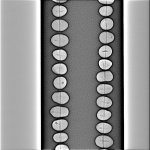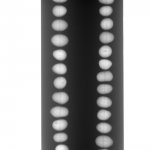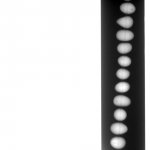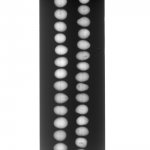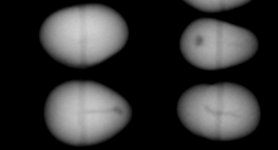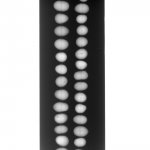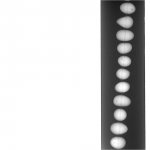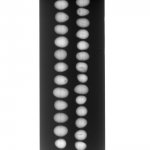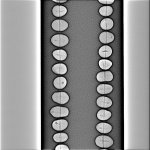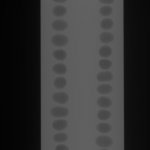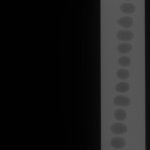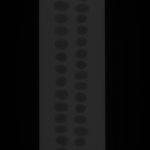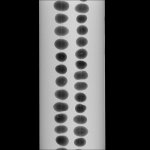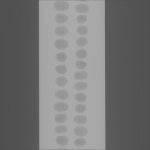Lagoon Island Pearls
Well-known member
- Joined
- Dec 8, 2009
- Messages
- 1,997
To the average person, they look random and dissimilar which gives rise to suspecting natural origin. However, to a trained eye, these appear to be the graded to the same luster, color and shape. If this stand were natural, grading around those three points would make for stunning, valuable strand.
This is not that strand. The first problem is pearl length. These are drilled on the narrowest plane which suggests mass production. The pearls are drilled for speed and efficiency and volume. Drilling lengthwise is a slower, tedious process and risks shattering pearls. A natural strand will usually have pearls drilled by length and will be graded and regraded time and time again until it has the perfect match suited for their visual effect. This strand looks like someone had a bag of pearls and a string, placing the next pearl without much thought.
The absence of a bead does not mean they have no nucleus. All pearls have a nucleus, but some natural pearls have no visible nucleus (albeit microscopic). Grafted tissue in cultured pearls always leaves a signature. A signature that is nearly identical to the rest of the pearls in the lot. Natural pearls will have markedly different nuclei. For that reason, I'd examine candled views, but be forewarned that drilled pearls are destroyed pearls from a scientific standpoint because much of the nuclear material is missing.
Freshwater pearls are graded into lots and sold by the sack. These are potato pearls. As far as potato pearls go, they are nice potato pearls. They were high graded to avoid circular ridges and other shape imperfections seen on other potato grades, but there are visible lines in the nacre itself. Any "circling" is typical of fast growth from cultural techniques. Circling observed in single natural pearls usually imply two or more nuclei are present.
lemanmls, I appreciate your concerns and accept your provenance at face value. However, the reputation of a pearl dealer does not suggest origin unless you have irrefutable evidence they were sourced from a natural pearler. Neither does age. Pearl culture has been going on for more than a century. Likewise, these do not look like fakes or anything other than what they were intended to be. Sometimes unscrupulous dealers will make intentional mismatches to give the appearance of being natural, but this strand does not present this way.
I use a scoring system to determine whether a strand should go top the lab or not. I apply a potential score of 10. Although not a firm standard, a score of 5 would merit a trip to the lab based upon a balanced speculation. These scored low. Giving this strand all benefit of doubt, it's 9 to 1 cultural origin. Of course, you may challenge my opinion by sending it to a lab, but please realize you may diminish their current value to near zero.
Natural vs CFWP
Luster ---------- 0.5 - 0.5 Consistent with either.
Shape ---------- 0.0 - 1.0 Graded match more common in CFWP.
Inclusions ----- 0.0 - 1.0 No visible inclusions other than circular growth fronts.
Matching ------ 0.0 - 1.0 Equal matches are possible, but drilling more consistent with mass production.
Structure ------ 0.5 - 0.5 Known to be terraced aragonite, consistent with either.
Size ------------ 0.0 - 1.0 Consistent with either but matched grade suggests cultural origin.
Color ----------- 0.0 - 1.0 Uniform and consistent with CFWP.
Translucency -- 0.0 - 1.0 Uniform and consistent with CFWP.
Onset----------- 0.0 - 1.0 100% perisostracial growth, consistent with CFWP.
Nuclear -------- 0.0 - 1.0 More uniform than not. No shell beads present.
Natural - 1
CFWP - 9
This is a very nice strand. It's a very good example of something I expect we'll see more of in the future. A classic production version of an early, quality strand from China.
Thank you for sharing it with us.
This is not that strand. The first problem is pearl length. These are drilled on the narrowest plane which suggests mass production. The pearls are drilled for speed and efficiency and volume. Drilling lengthwise is a slower, tedious process and risks shattering pearls. A natural strand will usually have pearls drilled by length and will be graded and regraded time and time again until it has the perfect match suited for their visual effect. This strand looks like someone had a bag of pearls and a string, placing the next pearl without much thought.
The absence of a bead does not mean they have no nucleus. All pearls have a nucleus, but some natural pearls have no visible nucleus (albeit microscopic). Grafted tissue in cultured pearls always leaves a signature. A signature that is nearly identical to the rest of the pearls in the lot. Natural pearls will have markedly different nuclei. For that reason, I'd examine candled views, but be forewarned that drilled pearls are destroyed pearls from a scientific standpoint because much of the nuclear material is missing.
Freshwater pearls are graded into lots and sold by the sack. These are potato pearls. As far as potato pearls go, they are nice potato pearls. They were high graded to avoid circular ridges and other shape imperfections seen on other potato grades, but there are visible lines in the nacre itself. Any "circling" is typical of fast growth from cultural techniques. Circling observed in single natural pearls usually imply two or more nuclei are present.
lemanmls, I appreciate your concerns and accept your provenance at face value. However, the reputation of a pearl dealer does not suggest origin unless you have irrefutable evidence they were sourced from a natural pearler. Neither does age. Pearl culture has been going on for more than a century. Likewise, these do not look like fakes or anything other than what they were intended to be. Sometimes unscrupulous dealers will make intentional mismatches to give the appearance of being natural, but this strand does not present this way.
I use a scoring system to determine whether a strand should go top the lab or not. I apply a potential score of 10. Although not a firm standard, a score of 5 would merit a trip to the lab based upon a balanced speculation. These scored low. Giving this strand all benefit of doubt, it's 9 to 1 cultural origin. Of course, you may challenge my opinion by sending it to a lab, but please realize you may diminish their current value to near zero.
Natural vs CFWP
Luster ---------- 0.5 - 0.5 Consistent with either.
Shape ---------- 0.0 - 1.0 Graded match more common in CFWP.
Inclusions ----- 0.0 - 1.0 No visible inclusions other than circular growth fronts.
Matching ------ 0.0 - 1.0 Equal matches are possible, but drilling more consistent with mass production.
Structure ------ 0.5 - 0.5 Known to be terraced aragonite, consistent with either.
Size ------------ 0.0 - 1.0 Consistent with either but matched grade suggests cultural origin.
Color ----------- 0.0 - 1.0 Uniform and consistent with CFWP.
Translucency -- 0.0 - 1.0 Uniform and consistent with CFWP.
Onset----------- 0.0 - 1.0 100% perisostracial growth, consistent with CFWP.
Nuclear -------- 0.0 - 1.0 More uniform than not. No shell beads present.
Natural - 1
CFWP - 9
This is a very nice strand. It's a very good example of something I expect we'll see more of in the future. A classic production version of an early, quality strand from China.
Thank you for sharing it with us.

